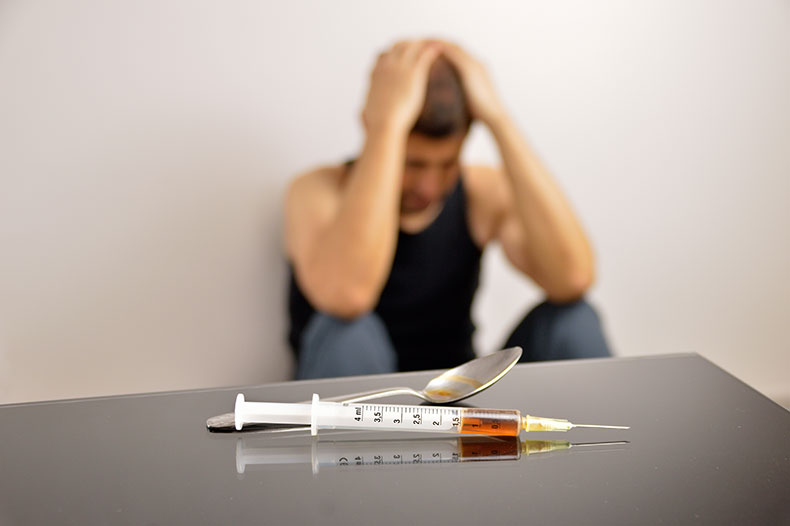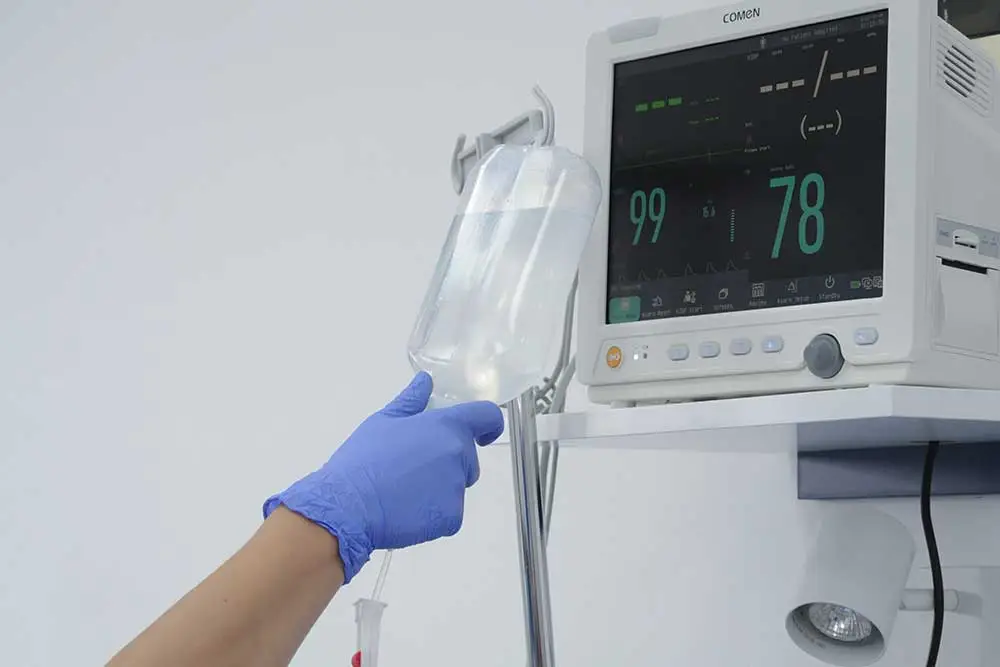How to recognize a heroin addict? How do you know that a loved one is struggling with addiction to this psychoactive substance? What symptoms should be paid attention to if there is a suspicion that a person has a heroin use disorder? What do the eyes of a heroin addict and the pupils of a heroin addict look like? What do the arms of a heroin addict and the face of a heroin addict look like?
These are some of the most common questions asked by family members or other close people of a heroin addict, wanting to help them as soon as possible. Watching a loved one struggle with this disease is certainly one of life’s most traumatic and painful experiences. It is very easy in this situation to feel confused, frustrated, helpless, sad.
Heroin is a powerful, potent and very dangerous drug that has an extremely high potential for addiction. This narcotic is a member of the opiate family that, when ingested, initially produces pleasurable sensations that include pain relief, relaxation, and euphoria. However, the way heroin acts on the central nervous system is so fatal and harmful that the heroin addict exposes himself to the risk of permanent health impairment, as well as the risk of death due to overdose.
Therefore, it is precisely the intense effect that heroin causes in the reward system in the brain that is the main reason why heroin addiction is an extremely widespread phenomenon, that is, a disease. Statistics show that every fourth person who tries heroin soon becomes addicted to it. Moreover, the addictive potential of heroin is so strong that this drug can cause physical and psychological dependence in a person after just one use!
If you suspect that a loved one is abusing heroin, in the following text we will try to give you an answer to the question “how to recognize a heroin addict” and what all the things may indicate that heroin addiction has occurred.
How to recognize a heroin addict - What is heroin addiction?
In order to know how to recognize a heroin addict, you first need to see what it is and how heroin addiction occurs.
Generally speaking, heroin addiction is a chronic and compulsive disease characterized by changes in the brain and uncontrolled behavior of the addict in search of this drug, despite all the harmful effects that heroin causes.
Heroin is a synthetic opiate, that is, an opioid analgesic derived from the Asian opium poppy plant. When used, heroin is converted to morphine in the body. Therefore, heroin cannot be found in nature as an isolated substance. Like cocaine, pure heroin is white in color, but as such it cannot be found on the black market. Heroin is an illegal narcotic that is used on the streets as a recreational drug. The color of heroin varies, depending on the mixture and the amount of substance that dealers add – from light brown to a brownish-reddish shade. Often, dealers add other substances to pure heroin, in order to increase their profits and the amount of this drug on the market (powdered sugar, gypsum, powdered detergent, etc.).
When a person uses heroin for the first time, they feel a rush of pleasure, joy and well-being (“high” feeling). These extremely intense and strong effects that heroin causes make a person crave and use heroin to the greatest extent possible, which quickly turns into tolerance and addiction.
Heroin can be abused in different ways: intravenously (most often), by smoking or by inhalation. Any method of using heroin quickly crosses the blood-brain barrier.
Heroin causes both physical and psychological dependence
Once heroin enters the brain, it is converted back into morphine, binding to opioid receptors found throughout the brain and body. Opioid receptors are involved in the perception of pain and reward, which is why heroin use enhances pleasant feelings while reducing pain.
Chronic use of heroin changes the chemical structure and functioning of the brain, which causes tolerance and dependence – physical and psychological.
Physical dependence on heroin is a condition when a person needs to continue using this drug in order to avoid unpleasant withdrawal symptoms (abstinence crisis). Their body has adapted and developed tolerance to this narcotic, which is why, without heroin, the addict’s body experiences a heroin crisis.
Psychological or mental addiction to heroin occurs when an individual strongly believes that they cannot function without heroin, and is characterized by an intense and uncontrollable craving for this drug.

Why does heroin addiction occur? Causes and risk factors
The goal of the answer to the question “how to recognize a heroin addict” is medical treatment of this disease as soon as possible, which is the only safe and reliable way to rid a person of this scourge. But, in order for the treatment of heroin addiction to be successful, it is not enough to treat only the symptoms of this disease, but to find and treat the reasons that contributed to the addiction in the first place.
What should be emphasized is that there is no single cause that leads to heroin addiction. It is believed that this disease is the result of several factors acting simultaneously, causing addiction.
Here are some of the most common risk factors for developing heroin addiction.
How to recognize a heroin addict and the signs of addiction
If you want to know how to recognize a heroin addict, the best way to do it is to pay attention to the following signs of heroin addiction. There are certain psychological, physical, behavioral and social indicators that can clearly indicate that a person is abusing heroin, as well as being addicted to this narcotic.
- The eyes of a heroin addict;
- Pupils of a heroin addict;
- The arms of a heroin addict;
- The face of a heroin addict.
We will talk about all this in more detail a little later, and now let’s look at the common symptoms of heroin addiction.
What should be pointed out is that not all symptoms will appear at the same time in every individual. Some symptoms may develop earlier, some later, some faster, and some slower, depending on numerous factors such as the duration of heroin use, the frequency of heroin intake, the amount, i.e. the dose taken, the purity of the heroin, the general psycho-physical health of the person, genetics and the like.
Psychological symptoms of heroin addiction
- Feeling of shame, guilt and depression;
- Hopelessness and despair;
- Decreased ability to focus and concentrate;
- Bad judgment;
- Mental confusion and disorientation;
- Memory problems;
- Hallucinations;
- Paranoia;
- Apathy and loss of motivation;
- Periods of hyperactivity followed by periods of exhaustion;
How to recognize a heroin addict and physical symptoms
- Significant unintentional weight loss;
- Exhaustion and lethargy;
- Watery and red eyes, as well as a runny nose;
- Myosis of the eye;
- Persistent flu-like symptoms;
- Constipation;
- Itching;
- Bruises and scabs on the skin;
- Cracked and collapsed veins;
- Sleep problems;
- Kidney and liver damage;
- Slow speech;
- Nausea and vomiting;
- Risk of infectious diseases, due to shared use of needles, such as hepatitis C and HIV;
- Pneumonia and tuberculosis;
- Dry mouth;
- Shortness of breath;
- Frequent respiratory infections;
Social symptoms of heroin addiction
- Avoiding family and friends;
- Connecting with a new group of acquaintances;
- Drastic mood changes and unprovoked outbursts of anger and aggression:
- Strained or destroyed relationships with loved ones;
- Job loss and unemployment;
- Financial problems;
- Problems with the law (a person often violates legal regulations in order to obtain a new dose of heroin);
- Social isolation;
Behavioral signs of heroin addiction
- Frequent absences from home, school, college or work;
- Poor performance in school, work or college;
- Possession of syringes or other paraphernalia that may contribute to the abuse of heroin;
- Loss of interest in previous activities or hobbies that used to fulfill the person;
- Neglecting and failing to fulfill daily household, school or business obligations;
- Wearing clothes with long sleeves, even in warm weather, in order to hide the signs or traces of intravenous heroin use;
- Lying, being secretive or otherwise misleading about your plans and activities.
Recognizing heroin addiction and 11 key criteria
Experimentation with heroin, due to the physical and psychological addictive potential of this drug, very quickly leads to addiction. According to the diagnostic and statistical manual, there are 11 criteria that indicate heroin addiction. The more criteria a person fulfills, the higher and more severe the degree and intensity of addiction. Therefore, if you are wondering “how to recognize a heroin addict”, we present you with a complete list of 11 sure criteria:
- Taking heroin in larger doses and/or for a longer period of time;
- Persistent desire and unsuccessful efforts to stop using heroin or to shorten and reduce its use;
- The person spends a lot of time and energy thinking about heroin, about the acquisition and use of heroin;
- Abstinence, i.e. sustaining from the use of heroin, which can be manifested in two forms: the characteristic unpleasant and painful symptoms of a heroin crisis, as well as the withdrawal of heroin or some chemically similar substance in order to alleviate the effects of an abstinence crisis (physical dependence);
- Repeated use of heroin leads to failure to fulfill obligations at home, at work or at school;
- Intense craving and strong desire to use heroin (psychological addiction);
- The person reduces or gives up important social, recreational or professional activities in order to be able to use heroin;
- Repeated use of heroin in situations where this substance is dangerous for a person’s physical and psychological health;
- Continued use of heroin, despite knowledge of existing physical and psychological problems caused by abuse of this substance;
- Tolerance to heroin, which can be reflected either as the need to take a larger dose of heroin at more frequent time intervals in order to achieve the desired effect or in the form of a significantly reduced effect of heroin with continued use of the same amount of this narcotic;
- Continued use of heroin despite impaired or aggravated social and interpersonal problems caused by the abuse of this narcotic.

What do the eyes and pupils of a heroin addict look like?
Many people who abuse prescription opiates (say, painkillers) often switch to heroin. Their families then often find themselves in agony, looking for an answer to the question of how to recognize a heroin addict. One of the most striking symptoms of heroin addiction is the eyes of a heroin addict, that is, the pupils of a heroin addict.
What do the eyes of a heroin addict look like? What causes changes in the eyes of heroin addicts? Namely, we have already listed certain physical, psychological, behavioral and social symptoms of heroin addiction. People on heroin are characterized by reddened skin, slower breathing, sudden weight loss, runny nose, neglect of personal hygiene, itchy skin, scabs or sores on the skin, and the like.
While all of these can be clear signs of heroin addiction, sometimes the most significant physical sign of heroin use is the effect this psychoactive substance has on the heroin addict’s eyes.
Namely, people who use heroin often have puffiness, that is, swelling under the eyes. A heroin addict’s pupils are small and constricted, while a heroin addict’s eyes may appear to be droopy. Also, the eyes of a heroin addict may be red and watery, with, therefore, bloodshot whites.
Heroin overdose and the pupil of a heroin addict
Unfortunately, in the world, but also in our country, the number of cases of overdose, that is, intoxication with heroin, is increasing, while the number of deaths due to overdose also continues to grow. Often, the pupils of a heroin addict can indicate whether intoxication with this psychoactive substance has occurred.
Namely, a heroin overdose occurs when a person consumes too much heroin in a short period of time or when the heroin, which the person abuses, contains other toxic chemicals or drugs. Some signs of heroin overdose include flaccid, relaxed muscles, loss of consciousness, being conscious but unable to communicate, respiratory depression, slow, shallow, and irregular breathing.
Other signs of overdose include choking or snoring sounds, vomiting, pale and clammy skin, bluish or purple nails and lips. Also, due to an overdose, the pupils of a heroin addict can be very small and constricted.
Does heroin dilate the pupils, i.e. the eyes of a heroin addict?
There are certain drugs that can cause the eyes to dilate, meaning that a person’s pupils become abnormally large. This phenomenon is called mydriasis, and it can occur when a person uses marijuana, cocaine, or amphetamines. The effect of pupil dilation, due to the use of the mentioned drugs, can last from several hours to several days.
So, does heroin dilate the pupils of a heroin addict? The answer is no. Opiates, including heroin, cause the pupils to constrict, a process called myosis.
What do the eyes of a heroin addict look like?
As we mentioned before, the eyes of a heroin addict tend to look sleepy or droopy, with very small and “pricked” pupils. A heroin addict’s eyes may be red or bloodshot, and there may be dark circles under them.
What causes a heroin addict’s eyes to look like this? More specifically, what causes the pupils of a heroin addict to constrict when using this opiate?
Namely, when heroin binds to opioid receptors in the brain, then the functionality of the entire central nervous system changes. When the pupils constrict or become small due to heroin use, it means that the drug is affecting the parasympathetic part of the autonomous nervous system. Therefore, constricted pupils can be one of the clear signs of heroin use, since most other psychoactive substances have the opposite effect, causing the pupils to dilate.
How to recognize a heroin addict and the arms of a heroin addict
In most cases, heroin is used by injection, i.e. intravenously, by injecting into a vein in the arm. This is precisely why the arms of a heroin addict can be a more than clear indicator that a person is addicted to this narcotic.
There is even a term called “heroin arm”, which refers to the scars and marks on the arms that occur when a person injects heroin into their system over a long period of time. Even if someone consumes heroin by smoking or snorting it, the person tends to switch to intravenous use of this drug.
The reason for this is that by injecting heroin, the effect of this drug is almost immediate and fast, which means that a person feels the effects within just a few seconds. On the other hand, in addition to the risks that heroin, as such, carries with it, there are additional health risks caused by injecting heroin.
Heroin addict's arms and marks on arms
If you want to know how to recognize a heroin addict, then you should definitely pay attention to the arms of a heroin addict, that is, to the marks on the upper limbs.
Often, people who use heroin for a long period of time become adept at hiding these traces. Not only can they inject heroin on other parts of the body, but as we mentioned, heroin addicts tend to wear long sleeves all year round.
There are many dangers associated with injecting heroin. First, the risk of overdose is significantly higher in the case of injection. Also, if someone injects heroin with other toxins or additives in it, it is extremely dangerous to put such a chemical mixture directly into the bloodstream, and the consequence can be death!
Furthermore, injecting heroin increases the risk of infectious diseases such as HIV/AIDS or hepatitis C, which is a consequence of needle sharing. Also, when a heroin addict’s arms have conspicuous and visible needle marks, it means that the person is at higher risk of complications such as inflamed or collapsed veins, skin infections and other problems.
Heroin infection of the arms
Heroin infection of the arms is a common complication of intravenous heroin use. Therefore, the arms of a heroin addict are susceptible to numerous infections.
Necrotizing fascitis is practically a flesh-eating infectious disease that occurs when bacteria enter tissue. The skin becomes swollen and hot, and the heroin addict often has symptoms such as fever, vomiting, and diarrhea. As this infection spreads, the skin can turn black and even cause death! Sometimes amputation is necessary.
In any case, the arms of a heroin addict may contain suitable marks that can clearly indicate that the person injects heroin. In many cases, it is the heroin addict’s hands that reveal whether someone is truly addicted!
What does the face of a heroin addict look like?
Often the family and closest friends of a person suspected of using heroin ask themselves – what does the face of a heroin addict look like? In other words, can a person’s face indicate that they are abusing heroin?
We have already pointed out what the eyes of a heroin addict look like, which are part of the face, and on the basis of which one can reasonably suspect that there is heroin abuse. On the other hand, a striking symptom of heroin abuse is a sudden loss of body weight, which can first be seen on the face of the addict. More specifically, weight loss affects the face of a heroin addict, making the person look tired, thin, malnourished, or older than they really are.
The reason for the weight loss is that heroin use disorder causes nausea, vomiting and loss of appetite.
Heroin addicts often have a dry mouth, often cough and have a runny nose. The face of a heroin addict may have dark circles around the eyes and a pale complexion. Heroin abuse also affects blood pressure as well as heart rate, so the face of a heroin addict can even have a bluish tint to the skin.
Since heroin addiction causes itchy skin, a person may scratch their face frequently, causing sores and scabs on the face. Also, in the case of smoking or snorting heroin, a person may have sores on the nose or lips. The skin around the eyes may be puffy or swollen.

Treatment of heroin addiction as the only path to complete recovery!
As we could see, how to recognize a heroin addict depends on many factors. If you notice any of the above symptoms of addiction in a loved one, that is, if you suspect that a loved one has a problem with heroin abuse, it is of great importance that you seek professional medical help as soon as possible.
If heroin addiction is recognized and treated in the early stages of the development of this disease, the chances of recovery are significantly higher!
Know that heroin addiction in every sense destroys the life of the addict, as well as their family. It is important to treat heroin addiction before it gets completely out of control. The first and right step towards this is treatment, detoxification and rehabilitation in a certified and authorized hospital for the treatment of addiction.
Don’t let heroin addiction take control of your family member or loved one’s life. MedTiM is a modern clinic for the treatment of all forms of addiction and a modern drug rehabilitation center. Our internationally recognized and well-known team of doctors and other experts with decades of experience in the treatment of addiction and substance abuse have proven that complete recovery from heroin addiction is possible thanks to our innovative, revolutionary and medically proven treatments.
Applying modern and reliable treatment methods in our hospital, equipped according to the latest world standards, as well as with an individual approach, we guarantee maximum care and healing for each patient. Regardless of the degree, severity or intensity of heroin addiction, we treat each patient with the utmost attention, dedication and care.
Heroin addiction becomes a thing of the past in just 14 days
Medical treatment for the treatment of heroin addiction at the MedTim clinic lasts 10 or 14 days.
What differentiates us from others is SAFE and PAINLESS detoxification, i.e. complete cleansing of the addict’s body from traces of heroin and other harmful substances. As part of the treatment of addiction to heroin and other opiates, we also apply the most modern ultra-rapid opioid detoxification. In addition to hospital treatment, which includes a combination of pharmacotherapy and psychotherapy and lasts 10 or 14 days, we also provide outpatient treatment that lasts 12 months from the day of discharge from the hospital, which helps to preserve and maintain the results of inpatient treatment.
At any time, 24 hours a day, seven days a week, our professional staff with many years of experience is at your disposal – psychiatrists, anesthesiologists, internists, psychologists, special pedagogues, medical technicians, security, as well as other non-medical staff.
MedTim is really one big team in which everyone jointly contributes to maintaining the quality of work at a high level, so that the treatment of heroin addiction is carried out according to the treatment plan and gives the expected successful results. We have cured even the most severe cases of heroin addicts, we will help you too!
We offer all patients transportation from the airport to our hospital, as well as return to the airport.
Treatment of heroin addiction in our clinic is aimed at getting each patient back on the path to a happy and healthy life. We are also available to the patient’s family for any type of advice and consultation. You can already contact the experts from our addiction treatment center.
MedTiM - Help for heroin addicts has never been closer and more reliable!



